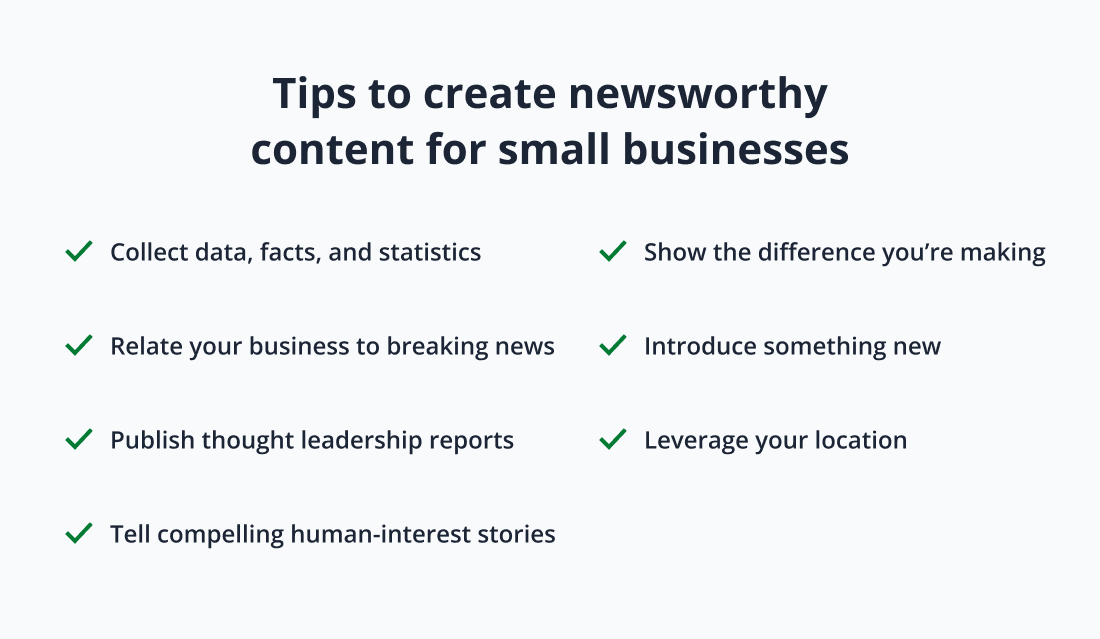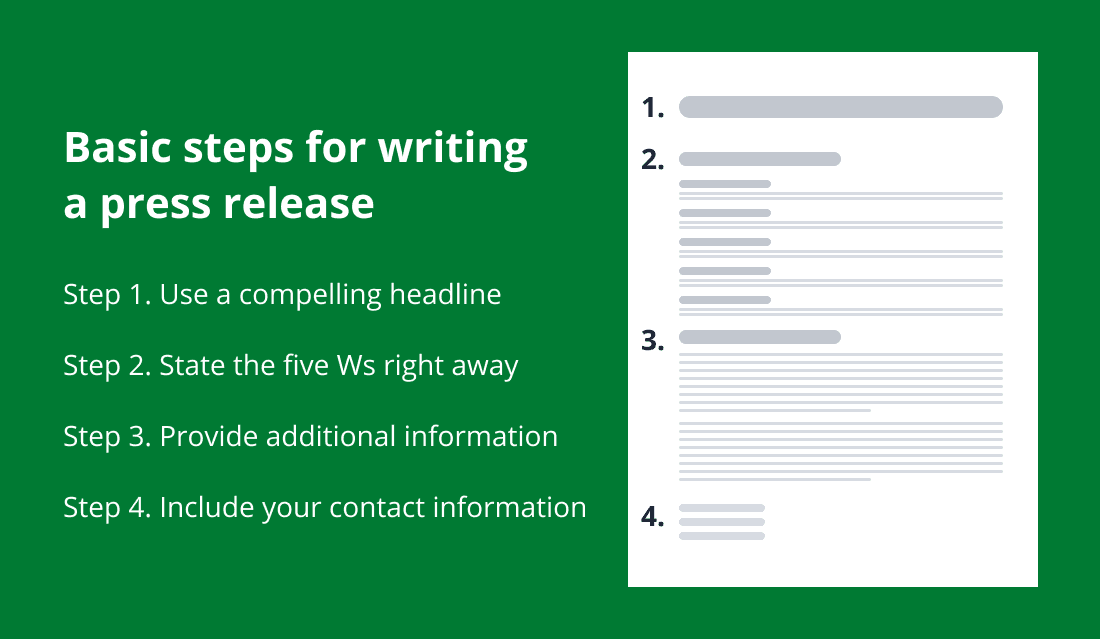Key takeaways:
- Your content becomes newsworthy when it directly affects many lives, addresses local concerns, or presents unique ideas.
- Strategies like backing up your content with hard facts or sharing the positive difference your business makes naturally attract public interest and media coverage.
- Make it easy for media outlets to discover and share your valuable content. Distribute your newsworthy stories through effective press releases, personalized email pitches, and strategic social media posts.
With millions of pieces of content available from various sources, it’s hard to know where to look or what to pay attention to. It’s becoming more difficult for small businesses to reach their intended audience with their marketing messages.
Small business owners need to create newsworthy and relevant content for their audience to break through the noise and get noticed.
In this article, we’ll discuss what makes a story newsworthy and provide tips on how to create newsworthy content. Plus, we’ll include how to get media outlets and journalists to cover your content.
What makes a story newsworthy?

Journalists and editors weigh specific factors to determine how important a story is and if it’s worth covering. The more of those elements a story possesses, the more likely it is to be newsworthy.
Here are the core components that contribute to a story’s newsworthiness:
Timeliness
People want to know what’s current, unfolding, and changing in their world. Creating content that reflects the latest developments ensures that your audience sees it as relevant and newsworthy.
However, timeliness isn’t only about what’s brand new. You can also make older information timely by connecting it to a recent event, new data, or a fresh perspective.
For example, a report on past economic trends becomes timely again when a new financial crisis emerges, as it offers important context. Smart content creators constantly look for ways to refresh and re-angle existing information to make it relevant to today’s conversations.
Impact
If there are a lot of people affected by a story, the more newsworthy it becomes. The “impact” element refers to how much a particular event or development will influence your audience, whether directly or indirectly.
Examples of these events could be:
- A new law that changes everyone’s taxes
- A major weather event
- A breakthrough in medicine
All these events have a high impact because they touch many lives.
So, when you create content, consider who your story will help, inform, or even challenge. Stories with broad consequences naturally draw a larger audience because they address universal experiences or widespread concerns.
Proximity
People care most about what’s close to them, both geographically and culturally. A fire down the street will always be more newsworthy to you than one on another continent, even if the distant fire is larger. This is because proximity makes a story feel more personal and directly relevant to your daily life.
You can leverage proximity by focusing on events happening locally. You can also highlight how a broader issue connects to your target audience’s specific community or shared experiences.
Even if your topic isn’t local, you can find common ground through shared values, interests, or challenges. Making your content feel “close to home” creates an instant connection with your readers.
Conflict
Conflict naturally generates interest because it creates tension and drama. Whether it’s a political debate, a sports rivalry, or a disagreement between individuals, stories with opposing forces naturally draw attention. We are often curious about how disputes will unfold and who will win.
However, when you incorporate conflict into your content, you don’t necessarily need to sensationalize. Instead, you can highlight the following:
- Different viewpoints
- Competing ideas
- Challenges that need solutions
Presenting both sides of an argument or exploring obstacles and triumphs makes your narrative more dynamic and newsworthy.
Human interest
Stories that tug at our emotions or showcase unique human experiences resonate deeply. These stories appeal to our shared humanity and allow us to connect with others on a deeper level.
Human interest content often focuses on:
- Personal journeys
- Acts of kindness
- Overcoming adversity
- Heartwarming moments
You can use the human-interest angle for almost any topic by looking for the personal stories behind the facts. Instead of only reporting statistics, find the story the statistics represent.
Adding a human element to your content can form an emotional connection with your audience, which, in turn, makes it newsworthy.
Prominence
People are naturally curious about well-known individuals, organizations, or institutions. If a famous person, a major company, or a prominent public figure is involved in a story, it automatically generates more interest. Their actions and statements often make headlines simply because of who they are.
You can use the prominence element in your content by:
- Featuring thought leaders
- Interviewing well-recognized names
- Quoting or referencing authoritative sources
Leverage the established recognition of others to boost your content’s newsworthiness.
Novelty
If something is unique or unusual, it becomes instantly newsworthy. Novelty captures attention because it defies expectations.
When creating content, look for the following examples to create a compelling story:
- A surprising twist
- An innovative approach
- A never-before-seen angle
- An unusual perspective
Highlighting what’s different or extraordinary about your subject can make your content unforgettable.
How to create newsworthy content for small businesses

To create newsworthy content for your small business, you should use strategies based on the elements of a newsworthy story. Consider these approaches to help you generate media coverage for your small business:
Collect data, facts, and statistics
Using real numbers and data in your news stories can make them more significant and engaging. This method also:
- Sets you apart from the competition
- Adds credibility to your content
- Provides valuable insights that news outlets will want to share
For instance, if you own a bakery, survey customers about their favorite pastries and share the results, or track how many new jobs your business created since last year.
These specific data points offer proof of your impact and expertise, making your business a prime candidate for a news story.
Relate your business to breaking news
Connecting your business to a trending topic makes it instantly more relevant. Look at what’s in the current news cycle, whether it’s an industry trend, a cultural shift, or a national conversation, and figure out how your business fits in.
This approach helps journalists easily incorporate your story into a broader narrative they’re already covering.
For example, if there’s a national discussion about sustainable practices, you could highlight how your small business implements eco-friendly initiatives.
By showing how your business addresses or is affected by current events, you offer a fresh perspective that media outlets will find valuable and timely.
Publish thought leadership reports
Establish your small business as an authority by writing about topics in your industry that you have substantial knowledge about.
Try these ideas to help you get started:
- Predict or report on trends that are emerging
- Share a trail-blazing idea you’ve been contemplating about
- Write about a cause you believe in
These kinds of content will help you get noticed or even get the media to cite you as a credible source in their stories.
Tell compelling human-interest stories
Weaving a captivating narrative into your story makes it more memorable and engaging. This often means sharing stories of real people, their experiences, or their achievements.
You can even share stories about your small business. Let’s say you’re competing against larger, more established companies. This gives your brand an underdog narrative that you can leverage.
Consider writing about:
- Your journey in building your small business
- Your CEO or founder’s unique background
- Your commitment to customers
- How you’re challenging the status quo
These stories can be incredibly compelling and resonate deeply with audiences who appreciate grit and determination.
Show the difference you’re making
Consider the broader relevance of your brand. How many people does your business or its initiatives affect? The greater the impact your content has on individuals, a community, or an industry, the more likely it is that journalists will pick it up.
Use these questions to determine the difference your business offers on a grand scale:
- Does your product solve a widespread problem?
- Does your service significantly improve people’s lives?
- What are the real-world implications of your business initiatives?
When you can clearly demonstrate a considerable impact, you make a strong case for why your story deserves to be told.
Introduce something new
Novelty sparks curiosity, and journalists are always searching for the next big thing to share with their audience. If you’ve just launched a new product or an innovative service, it’s a good idea to showcase it through your content.
Clearly explain what makes your new product or service unique and how it benefits customers or solves their problem. Make it a truly compelling piece of news by highlighting the originality and impact of what you do.
Leverage your location
Featuring your local roots and contributions makes your business more relevant to community news outlets and their readers. Whether you’re opening a new branch in a nearby town or participating in a local event, emphasize your connection to the community.
News organizations often look for stories that resonate with their local audience. By focusing on your impact within a specific city or neighborhood, you provide them with content that directly appeals to their readership.
This can include sponsoring local sports teams, contributing to community projects, or simply detailing how your business serves the local population.
How to get media coverage for your newsworthy content
You can get news and media outlets to cover your content in many ways. However, you can focus on these three main approaches to get the ball rolling:
- Writing effective press releases
- Using direct media outreach
- Leveraging social media
Write effective press releases
In a business perspective, a press release announces to the public a newsworthy event happening within your company. It could be a product launch or a grand opening of a new branch.
Now, a well-crafted press release is like a formal invitation to media outlets and journalists that urges them to cover your story. Follow these fundamental steps for creating an impactful press release:

Step 1. Use a compelling headline
Your headline should immediately grab the reader’s attention and clearly summarize your main news. This could make or break your chances of getting media coverage for your content.
Step 2: State the five Ws right away
The first paragraph, often called the “lead,” should contain the five Ws:
- Who
- What
- When
- Where
- Why
This allows busy editors or journalists to grasp the core of your story from the very beginning and decide if it’s relevant to their audience.
Step 3. Provide additional information
Elaborate on the details of your news in the following paragraphs. To do this, you can:
- Explain the significance of your announcement
- Include relevant background information about your business
- Add quotes from important individuals, like yourself or a satisfied customer
Keep the language concise, factual, and free of jargon. A strong press release acts as a blueprint for a news story, making it easier for news outlets to run with it.
Step 4. Include your contact information
Always include your contact information so that news and media organizations can easily reach out for more details or interviews.
You should also add a boilerplate at the end, which is a brief description of your company and its mission. This gives journalists a quick overview of your business.
Use direct media outreach
Publishing a press release is a good start, but direct media outreach takes your efforts a step further. This involves personally contacting journalists, editors, and producers who cover your industry or local area.
You can use your media outreach tactic in two ways: send personalized email pitches and build media relations.
Sending personalized email pitches
Before you reach out, research reporters who consistently cover topics related to your industry. Then, tailor your pitch to each individual, demonstrating that you understand their work and why your story would resonate with their audience.
When you pitch, make sure you:
- Explain why your story is relevant to their readers or viewers
- Highlight the unique angles or benefits of your news
- Offer them an exclusive interview, a product demonstration, or access to a unique perspective
Easily get them to say yes by providing all the necessary information, but also be concise and respectful of their time. If you don’t hear back, follow up with them politely but avoid being persistent to the point of being a bother.
Building media relations
Creating relationships with the media over time is invaluable. You can do this in many ways, such as:
- Attending industry events
- Connecting with them on social media
- Providing them with valuable information even when you don’t have a specific story to pitch
By becoming a trusted source, you position your business as a reliable voice when they’re looking for a story related to your expertise.
Leverage social media
Social platforms are powerful tools for sharing newsworthy content directly with your audience and attracting media attention. When you have exciting news, share it broadly across your business’ social channels.
Use the power of social media by:
- Publishing engaging posts that summarize your updates
- Producing interesting visuals for your business’ Instagram photos or TikTok videos
- Using relevant hashtags to reach a broader audience interested in your industry
- Responding to your audience’s comments and questions promptly
- Encouraging your followers to share your content
- Tagging relevant media outlets or journalists in your posts, especially if you have a relationship with them
- Highlighting customer success stories
- Showcasing behind-the-scenes glimpses related to your announcement
The more compelling and shareable your social content is, the greater the chance it will gain traction and potentially catch the eye of media professionals.
Create a buzz with your newsworthy content

To create newsworthy content for your small business, you’ll need to be mindful of the important elements of a newsworthy story. These include impact, novelty, and timeliness.
Incorporate them into your content strategy and use press releases and social media to get media coverage for your content.
To take it further, consider partnering with Network Solutions for your digital marketing needs. We offer expert consultation services on website design, pay-per-click (PPC) advertising, business directory listings, and more.
Contact us today, or read our articles about search engine optimization (SEO) and marketing to help your small business grow:
- Top SEO Tips for Small Businesses To Grow Your Website
- How To Create an Effective SEO Strategy
- Storytelling in Marketing: How To Build Authentic Connections
- Marketing Strategy: Definition, Examples & Business Impact
Frequently asked questions
You can find trending topics by:
Observing what people discuss on social media platforms like X or Reddit
Looking at what news outlets in your industry frequently cover
Using free tools like Google Trends to research what people are searching for online
Paying attention to what your audience consistently asks about or expresses interest in
Staying current on general news to spot broader trends
To make your content stand out, offer a fresh perspective on a topic. Then, supplement it with engaging videos, images, or infographics.
The most common mistakes to avoid when creating newsworthy content are:
Focusing on personal opinions or beliefs instead of objective facts
Using sensationalized language or making exaggerated claims
Failing to provide evidence to support claims
Writing in a complex or jargon-filled style
Creating content that sounds like an advertisement
Understanding your audience’s interests helps you create content they actually want to read. When you know their pain points or questions, you can offer solutions or insights.
This relevance builds trust and makes them feel like you truly understand them. Content that resonates with your audience achieves better results and keeps them coming back.




